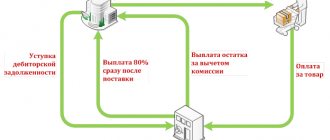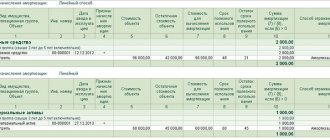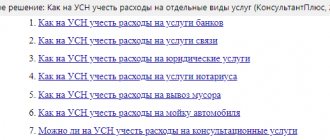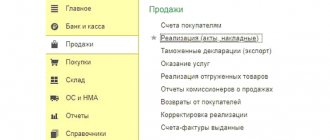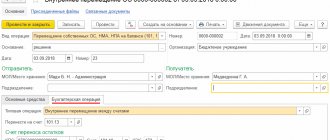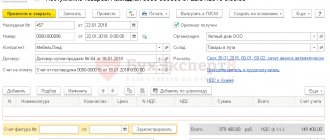Concept and types of services
Services are a type of activity that does not have a material expression, the results of which are sold and consumed in the process of economic activity of the enterprise (Clause 5 of Article 38 of the Tax Code of the Russian Federation).
Services exist in a wide variety, in particular:
- informational;
- audit;
- transport;
- storage;
- consulting;
- real estate agents;
- communications;
- training, etc.
In accounting, all services are included in costs based on primary accounting documents.
The main primary documents confirming the execution of services are:
- Agreement.
- Certificate of completion of work or other document confirming acceptance of services.
IMPORTANT! The Ministry of Finance believes that if the agreement does not provide for a clause on drawing up an act, then it needs to be drawn up only in cases provided for by law (letter dated November 13, 2009 No. 03-03-06/1/750). The Civil Code obliges to draw up an act confirming the acceptance of work only in the case of a construction contract (Article 720 of the Civil Code of the Russian Federation).
The procedure for concluding and terms of the contract for the provision of services are regulated by Ch. 37–41, 47–49, 51, 52 Civil Code of the Russian Federation. The main actors in the contract are the contractor and the customer of the services. Let's look at the accounting procedures for each of them.
Accounting for services from the contractor
The contractor's accounting directly depends on the type of activity and taxation regime. Most often, companies providing services in order to reduce the tax burden choose special regimes: simplified tax system (for individual entrepreneurs and LLCs) or PSN (for individual entrepreneurs). Along with them, OSNO can also be used.
ATTENTION! A new special regime for SMEs is expected from 2022. See details here.
- Income accounting.
Revenue from services provided is income from ordinary activities. The procedure for its accounting is regulated by clause 5 of PBU 9/99.
Postings from the contractor when selling services will be as follows:
- Dt 62 Kt 90.1 - reflects the sale of services.
- Dt 90.3 Kt 68 - VAT charged.
- Dt 90.2 Kt 20 (23, 25, 26, 43) - the cost of services provided is written off.
- Dt 50 (51) Kt 62 - services paid for by the customer.
- Cost accounting.
Cost accounting for companies engaged in the provision of services has its own specifics, since it depends on the specific type of activity. If a company is engaged in the provision of services that do not require material investments (for example, information, auditing or the like), then all costs are collected in the debit of account 20 “Production expenses” (clause 5 of PBU 10/99).
Consider, for example, training services. The main costs are salaries of employees, calculation of taxes and contributions, depreciation, etc. That is, to provide these services, the organization does not spend material assets on the production of any objects. At the end of the month, its costs are written off to the cost of sales by posting Dt 90.2 Kt 20.
If the company provides services and at the same time produces some material assets, then cost accounting is organized using accounts 20 “Production expenses”, 26 “General expenses” to account for management costs, and, if necessary, the 25th account “General production expenses” is used. expenses". Produced objects are accounted for on account 43 “Finished products”.
Example
Modern LLC provides outdoor advertising services. Assorted LLC ordered a banner for the store. The amount under the contract was 38,335 rubles. (including VAT RUB 6,389.17).
Postings in the accounting of Modern LLC:
- Dt 51 Kt 62 — 38,335 rub. — payment was received from Assorti LLC.
- Dt 62 Kt 90.1 — 38,335 rub. — sales of services are reflected.
- Dt 90.3 Kt 68 - 6,389.19 rub. — VAT is allocated.
Materials in the amount of 17,342 rubles were spent on the production of the banner. (excluding VAT). The remuneration of employees amounted to 8,500 rubles, contributions from the payroll - 2,805 rubles.
Postings:
- Dt 20 Kt 10 - 17,432 rub. — materials for making the banner were written off;
- Dt 20 Kt 70 - 8,500 rub. — wages accrued to employees;
- Dt 20 Kt 69 - 2,805 rub. — contributions from the payroll are calculated.
According to the accounting policy, Modern LLC keeps records of finished products at actual cost.
- Dt 43 Kt 20 - 28,737 rub. (17,432 + 8,500 + 2,805) - the banner was made at the actual cost.
- Dt 90.2 Kt 43 - 28,737 rub. — the cost of services is written off.
Do you want to know what risks the contractor may have when concluding a contract for the provision of paid services? Sign up for a free trial access to the ConsultantPlus system and proceed to the Guide to Contractual Work.
Accounting entries for sales of goods and services
The procedure for recording the sale of goods in transactions depends on the moment of revenue recognition. So, for example, if the company determined the date of shipment of goods as the moment of recognition of revenue, then typical transactions will be as follows:
| Operation | Debit | Credit |
| Reflected revenue for shipped products | 62 | 90-1 |
| Cost of goods sold written off | 90-2 | 41 |
| VAT is charged on the cost of goods and materials | 90-3 | 68 |
| Costs associated with selling products to customers are reflected | 90-5 | 44 |
| Payment for products has been received at the company's cash desk | 50 | 62 |
If the company recognizes the fact of accrual of revenue at the time of receipt of payment for goods sold, then the accountant will reflect the sale of inventory items with the following entries:
| Operation | Debit | Credit |
| The company shipped the goods | 45 | 41 |
| Value added tax charged | 76 | 68 |
| Payment received from buyers | 51 | 62 |
| The cost of shipped goods and materials is written off | 90-2 | 45 |
| VAT accrued upon shipment of goods is accepted for accounting | 90-3 | 76 |
| Costs associated with production and sales are written off | 90-5 | 44 |
Accounting for services from the customer
Services are expenses of the customer enterprise and are most often included in expense accounts 20 (23, 25, 26, 44).
Let's continue the example
The accountant of Assorti LLC will make the following entries in the accounting:
- Dt 60 Kt 51 - 38,335 rub. - paid for advertising.
- Dt 44 Kt 60 - 31,945.81 rub. — advertising costs are taken into account.
- Dt 19 Kt 60 — 6,389.19 rub. — input VAT is taken into account.
However, some services may increase the cost of purchased goods or fixed assets (clause 11 of FSBU 5/2019, clause 12 of FSBU 6/2020), for example, transport or information services. In this case, they are reflected as follows:
- Dt 08 (10, 41) Kt 60 - the cost of fixed assets (inventory, goods and materials) has been increased by the amount of transport or other services to be included in the price.
How to take into account the costs of commissioning work when applying the new FSBU 26/2020 “Capital Investments” and FSBU 6/2020 “Fixed Assets” from 2022, find out in ConsultantPlus. If you do not have access to the K+ system, get a trial demo access for free.
For the procedure for forming the cost of fixed assets and inventory items, see the articles:
- “Fixed assets in accounting (nuances)”;
- «What entries reflect transportation costs?.
Do you want to know what risks a customer may have when concluding a contract for paid services? Sign up for a free trial access to the ConsultantPlus system and proceed to the Guide to Contractual Work.
Primary documents for accounting services
In tax accounting, services are also included in costs and reduce taxable profit, subject to economic justification and the availability of primary accounting documents (Article 252 of the Tax Code of the Russian Federation). The exception is standardized expenses, when only part of the costs according to the rate specified in tax legislation is included in the base when calculating profits.
As noted above, most often, to confirm the fact that the service has been provided, a certificate of completion of work is drawn up. The form of the act is not contained in the album of unified forms (with the exception of the KS-2 form); it is developed and agreed upon by the parties to the agreement independently, taking into account the conditions of each specific transaction. In this case, the form must contain the mandatory details listed in Art. 9 of the Law “On Accounting” dated December 6, 2011 No. 402-FZ:
- Name and date of the document.
- The name of the company that prepared the document.
- The name of the work performed, indicating the cost and quantitative characteristics.
- Signatures of the parties indicating the positions and names of the signatories.
For a sample of filling out the acceptance certificate for completed work, see the material “Acceptance certificate for completed work - sample.”
The fact of provision of construction services is confirmed by an act in the KS-2 form.
The algorithm for filling out this document is given in the article “Acceptance certificate for completed construction work - sample”.
When providing transport services by a carrier company, in addition to the work completion certificate, there must be transport documents. Such documents, in particular, include invoices.
IMPORTANT! Since 2013, unified forms are not mandatory for use; organizations have the right to develop them independently.
The procedure for accounting for transportation costs is described in detail in the publication “Transportation costs are charged to the buyer’s account - posting.”
Postings for services received from third parties
Let us consider in more detail how to attribute the services of third-party organizations in transactions using the example of receiving various types of services.
Example 1. Receipt of communication services
Expenses for communication services are reflected in accounting in accordance with paragraph 18 of PBU 10/99 “Expenses of the Organization”; in tax accounting they are reflected in accordance with subparagraph 25 of paragraph 1 of Article 264 of the Tax Code of the Russian Federation.
Let’s say the supplier Svyaz LLC provides communication services to Vesna LLC. According to the contract, the cost of communication services per month is 14,750 rubles, incl. VAT 18% - 2,250 rub. Costs for services are included in the organization's expenses.
The accountant of Vesna LLC reflected the receipt of communication services from the supplier with the following entries:
| Debit Account | Credit Account | Transaction amount, rub. | Wiring Description | A document base |
| 26 | 60.01 | 12 500 | The cost of communication services in the current month is taken into account | Certificate of services rendered, Invoice received |
| 19.04 | 60.01 | 2 250 | VAT amount included | |
| 68.02 | 19.04 | 2 250 | The VAT amount is accepted for deduction | |
| 60.01 | 51 | 14 750 | Payment to the counterparty for services rendered | Bank statement |
Example 2. Purchasing pre-sales services
Expenses for pre-sale preparation are reflected in accounting in accordance with paragraph 6 of Article 226 of the Methodological Instructions, and in tax accounting are reflected in accordance with Article 265 of the Tax Code of the Russian Federation.
Let’s assume that Vesna LLC transferred its goods in the amount of 250 pieces to the counterparty for polishing. The cost of the pre-sale preparation service under the contract is 61,950 rubles, incl. VAT 18% - RUB 9,450. According to the accounting policy, service costs are classified as indirect costs.
The accountant of Vesna LLC reflected the services provided for pre-sale preparation of goods with the following entries:
| Debit Account | Credit Account | Transaction amount, rub. | Wiring Description | A document base |
| 44.01 | 60.01 | 52 500 | The cost of services provided is taken into account | Certificate of services rendered, Invoice received |
| 19.04 | 60.01 | 9 450 | VAT amount included | |
| 68.02 | 19.04 | 9 450 | The VAT amount is accepted for deduction | |
| 90.07.1 | 44.01 | 52 500 | Distribution costs are written off as financial results | Help-calculation of write-off of indirect expenses |
Example 3. Receipt of cash register maintenance services
For example, Vesna LLC purchased a cash register machine (CCM) worth RUB 10,207, incl. VAT 18% - RUB 1,557. For commissioning work, 1,062 rubles were paid, incl. VAT 18% - 162 rubles. An agreement was concluded with the KKM Technical Service Center for monthly KKM maintenance, the cost of the service is 295 rubles, incl. VAT 18% - 45 rub.
Under the conditions of the example, maintenance costs are included in the organization's expenses. The accountant of Vesna LLC reflected cash register servicing services with the following entries:
| Debit Account | Credit Account | Transaction amount, rub. | Wiring Description | A document base |
| 44.01 | 60 | 250 | The amount of expenses for KKM maintenance is taken into account | Certificate of services rendered, Invoice received |
| 19.04 | 60 | 45 | VAT amount included | |
| 68.02 | 19.04 | 45 | The VAT amount is accepted for deduction |
Results
Accounting for services is based on accounting standards. The accounting methodology is specific and depends on the specific type of activity of the performing company. Revenue from the provision of services is included in income from ordinary activities. Expenses are recorded as costs from normal activities in cost accounts. In the production of material assets necessary for the performance of services, finished product release account 43 is used.
For the customer, the cost of services is recognized as an expense and is charged either to cost accounts or to an increase in the purchase price of assets for which these services are related.
You can find more complete information on the topic in ConsultantPlus. Free trial access to the system for 2 days.
Reflection of the sale of services in accounting
All expenses related to the provision of work and services are usually classified as expenses for ordinary activities.
Distinguish between: (click to expand)
- depreciation expenses;
- social payments needs;
- employee salary expenses;
- material costs;
- and others.
Direct (main) costs are those that are directly related to the production process (salaries, insurance payments, etc.).
Indirect (overhead) costs are those incurred in the course of managing and maintaining the company (depreciation, management salaries, utilities, rent, etc.).
Which costs will be recognized as direct and which as indirect, the enterprise decides, based on the specifics of the activity.
In relation to the provision of various services and the performance of work, the “Custom-made” cost calculation method is applicable, when all costs are calculated for a specific order or a set of similar orders. For each of them, a card is created indicating the order No., the work being carried out, and the timing of its completion. Expenses are recorded as obligations under the contract are fulfilled.
